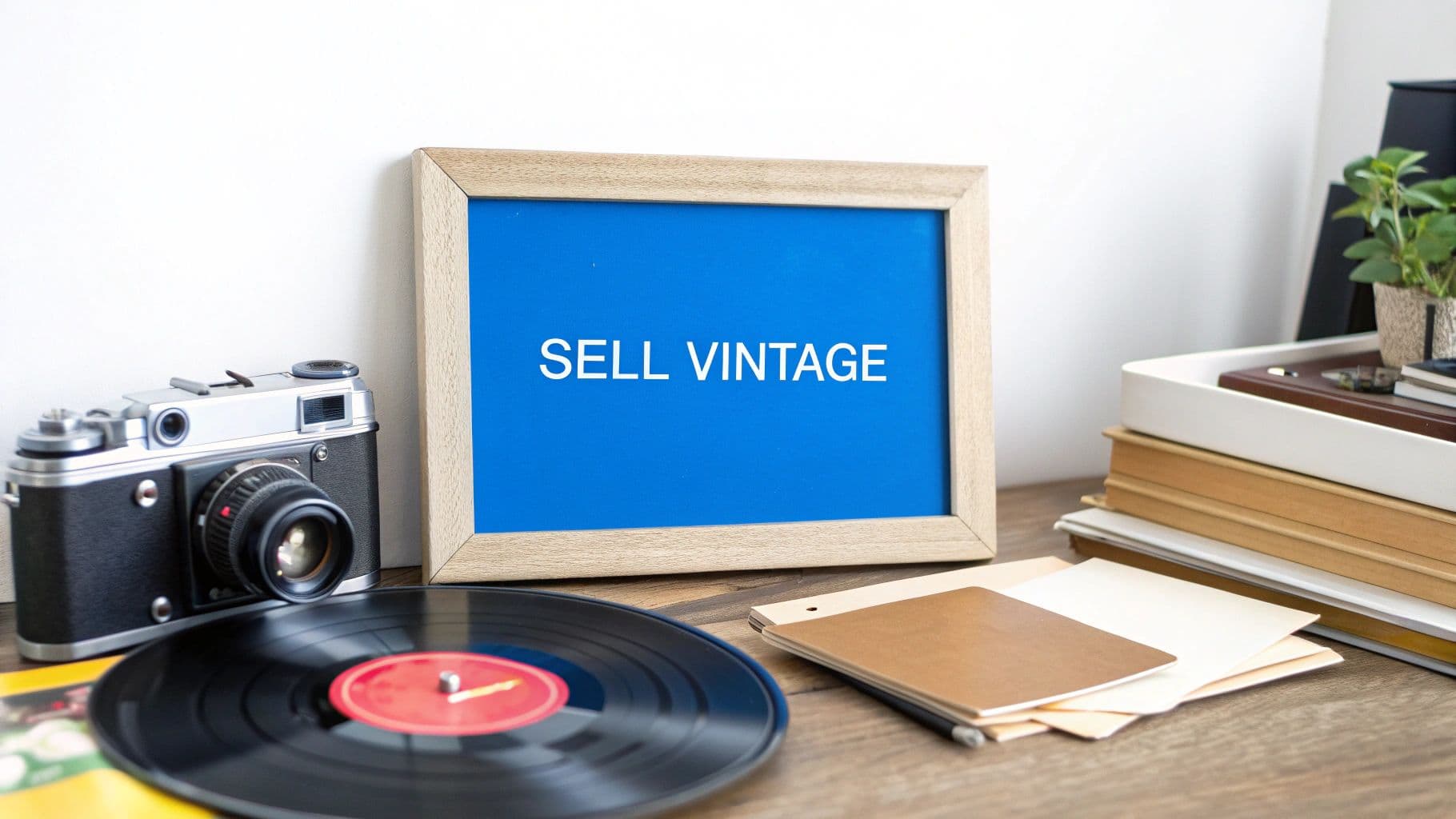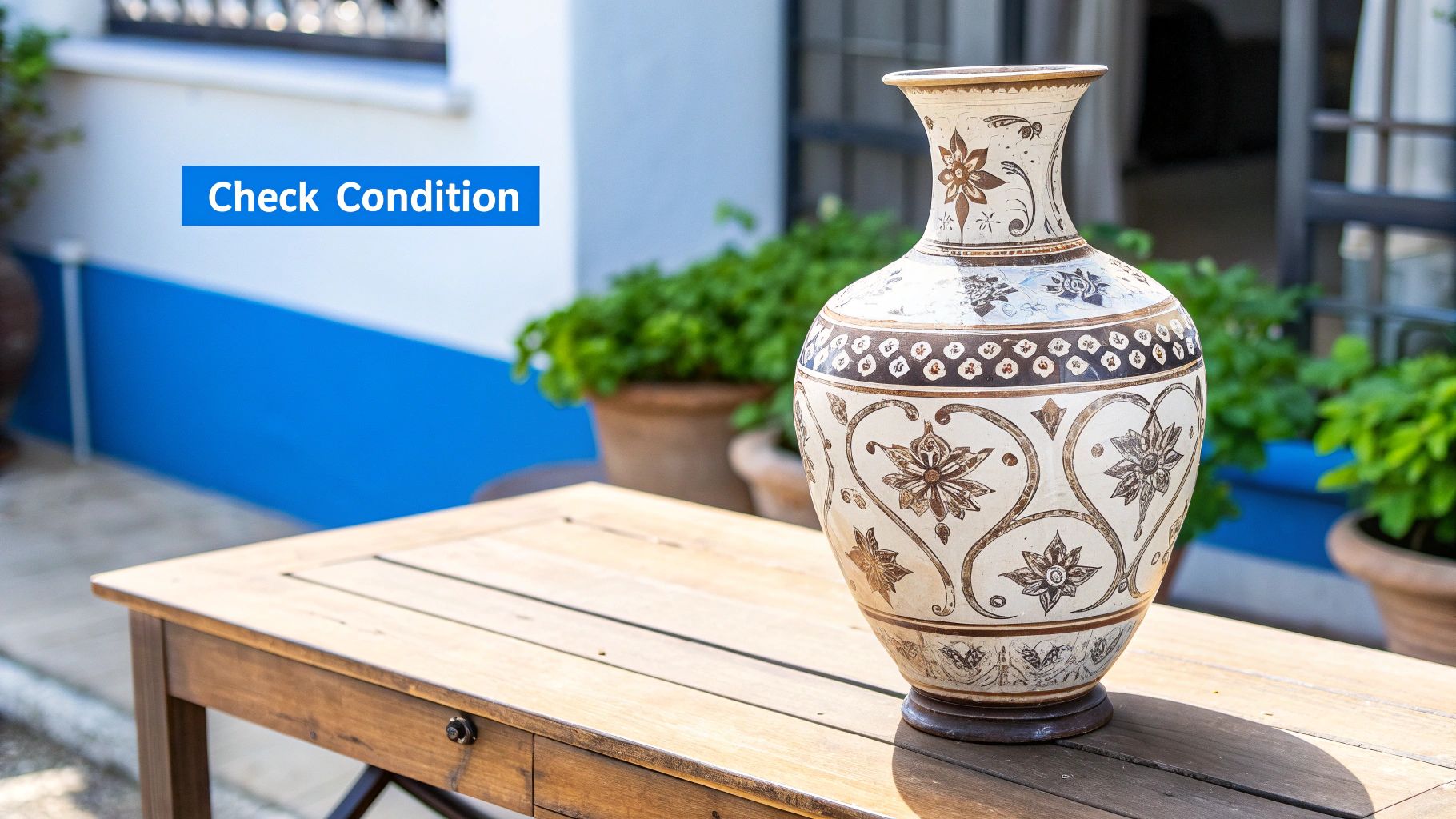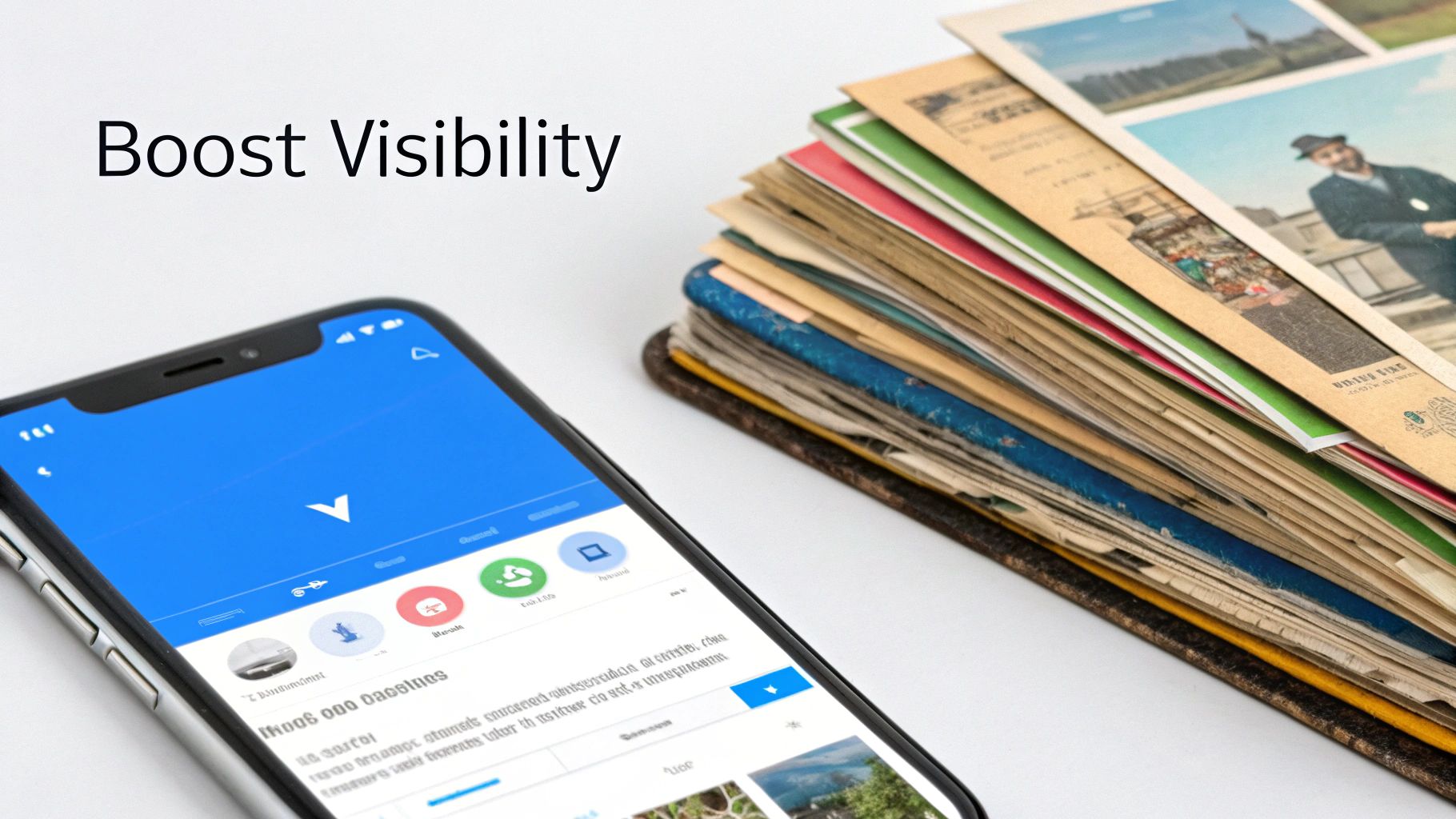How to Sell Vintage Items: A Pro's Expert Guide

Selling vintage isn't just a hobby; it's about turning history into a thriving business. It means finding those one-of-a-kind pieces, uncovering their stories, and connecting them with buyers who appreciate true character and quality.
Why Selling Vintage is a Smart Move Right Now
The appeal of vintage goes way beyond simply clearing out the attic. Today’s market is fueled by a perfect storm of consumer trends: a desire for sustainability, a thirst for unique items, and a real connection to tangible history. People are actively turning away from mass-produced goods, creating a massive opportunity for sellers who know where to look.
This is about more than just 'old stuff.' You're participating in the circular economy, giving well-made items a second, third, or even fourth life. Buyers aren't just hunting for a deal; they're looking for pieces with a story, craftsmanship, and a soul that modern products often lack. From a mid-century modern armchair to a classic 1980s band t-shirt, every item has a narrative that clicks with a specific audience.
The Market is Booming
The growth in this space is impossible to ignore. The global market for second-hand collectibles was valued at an incredible $142.5 billion in 2024. Projections show it could rocket to $248.9 billion by 2034. You can read more about the collectible market's impressive growth on GlobeNewswire.
This boom is your invitation. When you learn to sell vintage items the right way, you tap into a dedicated customer base that's already looking for what you have. They aren't just buying a product; they're taking home a piece of the past.
Key Insight: The best vintage sellers think of themselves as curators. Your job is to connect people with objects that hold real meaning, nostalgia, and timeless style. You find the gems and present them to a world that's ready to appreciate them.
Your Quick-Start Guide to Selling Vintage Items
To turn this opportunity into profit, you need a clear game plan. This guide is your roadmap, giving you actionable steps for every stage of the journey—from finding your first item to shipping it to a happy customer.
Think of this table as your cheat sheet. It breaks down the entire process so you can build a successful vintage business from scratch.
| Phase | Key Action | Pro Tip |
|---|---|---|
| Sourcing | Find unique items at estate sales, thrift stores, and online auctions. | Build relationships with flea market vendors for early access to inventory. |
| Pricing | Research comparable sold listings to determine market value. | Factor in rarity and condition; don't just copy other active listings. |
| Listing | Take high-quality photos and write descriptive, story-driven titles. | Use natural light and highlight unique details as well as any flaws. |
| Selling | Choose between auction-style or fixed-price formats on DIYAuctions. | Use auctions for rare items and fixed prices for items with known values. |
| Fulfillment | Pack items securely and communicate with the buyer. | Master the double-boxing method for fragile goods to prevent damage. |
Following this framework will set you on the right path, helping you navigate the exciting world of vintage selling with confidence.
Finding and Authenticating Vintage Treasures

The real secret to a profitable vintage business isn’t some slick marketing trick. It’s the quality of what you're selling. Before you can think about making money, you have to master the art of the hunt—finding and verifying great pieces. This means looking beyond the picked-over shelves at your local thrift store and knowing where the real treasures are hiding.
Estate sales should be your number one destination. Think about it: you’re getting access to entire collections curated over a person's lifetime. The key is to get there early, go in with a list of what you're looking for, and be willing to dig through every last box.
Flea markets are another potential goldmine, but success here comes down to building relationships. Once you get to know the regular vendors, you'll find they often hold back their best stuff for the buyers they know and trust. Online auctions can also turn up amazing finds, but you absolutely must do your homework on shipping costs and scrutinize the photos before you bid.
The Art of Authentication
Okay, so you've found something that looks promising. That's only half the job. Now you have to make sure it's the real deal. This is what separates the pros from the hobbyists. A good fake can easily fool an untrained eye, but there are always little details that give them away.
I once almost shelled out good money for what was listed as a "mid-century" ceramic vase. It looked right at first glance, but then I flipped it over. The base was perfectly smooth and felt modern—a dead giveaway that it was a recent knockoff.
Here’s what I've learned to look for when authenticating a piece:
- Maker's Marks: Get familiar with the logos, stamps, and signatures of well-known brands. Are they crisp and correct for the period? Forged marks often look blurry or just a little "off."
- Material and Wear: Authentic vintage items show their age in a natural, graceful way. Look for a genuine patina on metal, consistent crazing on old ceramics, or gentle, even fading on fabrics. Artificial aging usually looks too uniform or aggressive.
- Construction: Pay close attention to how an item was put together. Hand-dovetailed joints on old furniture, single-stitching on clothing made before the 1990s, and hand-painted details on porcelain are all great signs of authentic craftsmanship.
Pro Tip: Never trust just one detail. A convincing maker's mark on a piece made with the wrong materials is a huge red flag. True authentication is about seeing how all the details—the mark, the materials, the wear, the construction—come together to tell a consistent story.
Building Your Knowledge Base
Your ability to spot a good deal is directly tied to your bottom line. Pick a few categories that genuinely interest you—maybe it's Depression-era glassware, 1970s vinyl records, or classic costume jewelry—and dive deep. The more you learn, the faster you'll be able to spot an underpriced gem that others have overlooked.
This kind of deep knowledge is more important than ever. The demand for unique, sustainable goods is exploding, especially in the US. In fact, recent data shows that around 60% of American buyers regularly shop for vintage items. Younger generations, in particular, are driving this trend. If you want to dig deeper, you can learn more about the trends driving the vintage market on FashionAftermath.com.
When you source intelligently and authenticate every piece with care, you're building a business on a foundation of quality and trust. Your customers aren't just buying an old object; they're buying your expertise and the confidence that their new treasure is genuine.
How to Price Your Vintage Finds for Profit
Let's talk about the most crucial part of turning your vintage hobby into a real business: pricing. Get it right, and you’ve got a profitable venture. Get it wrong, and you're left with either a pile of dusty inventory or the feeling you’ve been short-changed. The sweet spot is where a buyer feels they got a fair deal, and you feel rewarded for your keen eye and hard work.
So, where do you start? Your first move is always research. You need to dig into what similar items have actually sold for. We call these "comps," or comparables. It’s easy to see what other sellers are asking for an item on DIYAuctions or elsewhere, but that’s just wishful thinking. The real gold is in the sold listings. That data tells you precisely what people are willing to pay right now.
Factors That Influence Price
Once you have a ballpark figure from your comps, it's time to zoom in on your specific piece. No two vintage items are truly identical, even if they look the same from a distance.
- Condition: This is everything. An item in pristine, near-mint shape will always fetch a premium. Be brutally honest here—chips, cracks, stains, or even significant crazing will bring the value down.
- Rarity and Demand: Is this a run-of-the-mill piece, or did you unearth a rare colorway or a limited-run item? Scarcity is your best friend. Think of a highly coveted Pyrex pattern or a unique "Made in Japan" figurine; those are the finds that create bidding wars.
- Brand and Provenance: A name brand with a solid reputation, like Fire-King for glassware or a well-known mid-century furniture designer, brings built-in value. If you happen to know the item's history (its provenance), that story can also add to its appeal and price.
Expert Insight: Pricing isn't a "set it and forget it" task. The market is always shifting. That hot ticket item from last year might be lukewarm today. The only way to stay ahead is to constantly keep an eye on those sold listings. It’s how you stay sharp and competitive.

As this image shows, your hard work in pricing comes to life through a compelling listing. It’s the final step that connects your well-priced item with its new owner.
Choosing Your Pricing Strategy
On DIYAuctions, you've got two main paths: a fixed price or an auction. Each has its place, and choosing the right one can make all the difference.
To help you decide, here’s a quick comparison of the most common pricing strategies for vintage sellers.
Vintage Pricing Strategy Comparison
| Pricing Strategy | Best For | Potential Downside |
|---|---|---|
| Fixed Price ("Buy It Now") | Common items with a clear, established market value. Great for stacking similar items. | You might leave money on the table if the item is more in-demand than you realized. |
| Auction-Style Listing | Rare, unique, or hard-to-value items where you want bidders to set the final price. | There's a risk of the item selling for a low price if bidding doesn't take off. |
| Auction with Reserve | High-value items where you need to protect your investment but still want the excitement of an auction. | The reserve price can sometimes deter initial bidders who feel it's set too high. |
Ultimately, picking the best strategy comes down to knowing your item and your goals for the sale.
A fixed price (or "Buy It Now") listing is your go-to for items where the market value is pretty clear. This is especially true for the booming second-hand homeware market, which is projected to rocket from $31.5 billion in 2025 to $53.9 billion by 2035.
On the other hand, an auction-style listing shines when you have something truly special or unusual, and you’re not quite sure what it’s worth. The competitive nature of an auction can drive the final price well beyond what you would have dared to ask.
If you want to dive deeper into valuation, be sure to check out our guide on how to determine fair market value. By matching your item to the right pricing method, you set yourself up for the best possible outcome.
Crafting Listings That Tell a Compelling Story
A fantastic vintage find can fall completely flat without a listing that does it justice. In the world of online selling, your words and pictures are your storefront, your salesperson, and your first impression all rolled into one.
Anyone can list the basic facts. The real secret to selling vintage is learning how to weave a narrative that helps a buyer picture your item in their own home. It’s about selling a feeling, not just an object.
You're not just selling a "used lamp"; you're offering a "charming 1960s ceramic table lamp with its original shade, just waiting to cast a warm glow over a cozy reading nook." See the difference? That little bit of story is what makes someone click "bid."
Taking Photos That Actually Sell
Let's get one thing straight: you don't need a professional camera rig. Your smartphone is more than capable of taking stunning photos, as long as you use your most powerful tool—good, natural light.
Forget your phone's flash. It creates harsh glares and washes out the true colors of your item. Instead, find a spot near a large window. An overcast day is your best friend here, as it provides soft, even lighting that makes everything look better.
To get those crisp, professional-looking shots, keep these pointers in mind:
- Keep Your Background Simple: The star of the show is your item, not your cluttered kitchen counter. A plain white wall, a piece of poster board, or even a clean patch of wood flooring works beautifully.
- Show Every Single Angle: Think like a buyer who can't pick the item up. Give them the full tour—front, back, sides, top, and bottom. The more they see, the more confident they'll feel placing a bid.
- Zoom in on the Details: This is where you really sell a vintage piece. Get close-ups of a maker's mark, an interesting texture, a hand-painted detail, or the unique patina on a piece of brass. These shots prove authenticity and highlight the character that makes vintage so desirable.
A Quick Word on Trust: Your photos have to be honest. That means showing any and all flaws clearly. Got a chip? A small stain? A bit of crazing? Take a well-lit photo of it. Hiding imperfections is the fastest way to earn a bad review and a return request. Honesty always wins.
Writing Titles That Get Clicks
In a sea of search results, your title is your one shot to grab a buyer's attention. To do that, you need to think like they do. What words would they actually type into the search bar?
A weak title sounds like this: "Old Blue Vase"
A strong, keyword-rich title looks like this: "Vintage Mid-Century Modern Blue Art Glass Vase, Murano Style, 10-inch Tall Decorative Accent"
That second title is packed with everything a serious buyer is looking for: the era (Mid-Century Modern), the material (Art Glass), the style (Murano Style), the size, and its potential use. This is how you get your listing seen.
Descriptions That Connect and Convert
Once your title and photos have pulled a buyer in, the description is where you seal the deal. This is your chance to expand on the story and provide all the critical details. Don't just list a bunch of measurements; bring the item to life.
Start with a short, engaging sentence that paints a picture. Instead of just "quilt," try something like: "Imagine this beautiful, handmade 1970s crazy quilt adding the perfect pop of bohemian charm to the end of your bed or draped over the arm of a sofa."
Then, follow up with the essential details in a clean, easy-to-scan format. Bullet points are perfect for this.
- Measurements: Always include height, width, and depth. Don't make them guess.
- Materials: What's it made of? Be specific (e.g., ceramic, oak, brass, wool).
- Condition: Briefly restate any flaws you photographed. Use honest but appealing terms like "gentle wear consistent with age" or "minor crazing visible on close inspection."
- Era/Style: Give your best estimate on the decade and style (e.g., Art Deco, Atomic Age, Farmhouse).
By combining beautiful photos with keyword-packed titles and story-driven descriptions, you create a listing that doesn't just show an item—it sells an experience. And that's how you turn casual browsers into happy buyers.
Getting It There Safely: Shipping and Customer Service

You did it. The auction’s over, and you made a sale. But hold the celebration for just a moment—the job isn't truly done until that unique vintage piece is sitting safely in its new home. Honestly, shipping is where so many new sellers get tripped up. With a bit of planning, though, you can protect your item, your profit, and your reputation.
Your packing skills directly reflect on you as a seller. Vintage items are often fragile, oddly shaped, or both, which means they need more care than just tossing them in a box with some tape. You have to invest in good materials. Trust me, it's far cheaper than refunding a buyer for a shattered treasure.
My go-to list of supplies is simple: sturdy new boxes (never trust a flimsy, used one), lots of bubble wrap, packing peanuts, and high-quality packing tape. This is not the place to cut corners.
For Fragile Items, Always Double-Box
When you’re dealing with anything remotely breakable, from a delicate ceramic vase to a stack of Jadeite plates, the double-boxing method is your best friend. I consider this technique non-negotiable for fragile goods. It might feel like overkill, but it has saved me from countless headaches and potential disasters over the years.
Here’s the breakdown:
- Start by wrapping your item snugly in a few layers of bubble wrap and taping it securely.
- Nestle that wrapped item inside a small, sturdy box. Fill any empty space with packing peanuts or crumpled paper so it can’t shift around.
- Now, place that smaller box inside a larger box. You want to leave a buffer of at least two inches on all sides.
- Fill that two-inch gap with more packing material—peanuts or air pillows work great. This outer layer is designed to absorb the inevitable bumps and drops of transit, leaving the inner box completely protected.
Key Takeaway: The whole point of double-boxing is to make the inner box "float." It should never touch the outer box's walls. This one technique is the single best way to prevent damage and avoid the pain of processing a return.
Nail Your Costs and Create a Great Experience
Figuring out your shipping costs before you list an item is critical. I’ve seen too many sellers wipe out their profits by undercharging. Once your item is packed up for its journey, weigh and measure the final package. Use the shipping calculator on DIYAuctions for a precise quote, and don't forget to add a little extra to cover the cost of your packing supplies.
Finally, remember that great service turns a one-time buyer into a loyal customer. It’s as simple as sending a quick, friendly message with the tracking number as soon as the item ships. This kind of proactive communication shows you care and builds immediate trust. A clear and fair return policy also gives buyers the confidence they need to place that bid.
A happy customer is your best marketing tool. They’re far more likely to leave a glowing review, which acts as social proof and helps you sell even more. It’s the final, crucial piece of building a successful side hustle. For those of you managing bigger collections, our guide on how to run an estate sale has fantastic strategies for tackling bulk inventory.
Got Questions About Selling Vintage Items?
Even with the best plan, you're going to have questions pop up as you get started. It happens to everyone. Below are some of the most common ones I hear from sellers who are just dipping their toes into the world of vintage.
What Are the Most Profitable Vintage Items I Can Sell?
This is the million-dollar question, isn't it? While the market is always shifting, some categories are evergreen. Think vintage band t-shirts, mid-century modern furniture, classic vinyl, and interesting jewelry—these almost always find a buyer.
For instance, certain kitchenware brands like Pyrex and Jadeite have a cult following and are often the first things snapped up at estate sales. But here's the real secret: the most successful sellers specialize in a niche they genuinely love. Your passion shines through, turning you into an expert who can spot hidden gems others might miss.
Pro Tip: Don't ever hide the flaws. Vintage buyers expect a little wear and tear, but they despise surprises. Honesty is your best policy for building trust and avoiding returns.
How Should I Handle Flaws on My Vintage Pieces?
Be brutally honest. You need to document every single imperfection, no matter how tiny, with clear photos and detailed notes in your description. This doesn't scare buyers away; it actually builds their confidence in you as a seller.
Use simple, direct language to describe any issues:
- "Shows character consistent with its age."
- "Minor chip on the back edge, as pictured."
- "Faint discoloration on the underside."
Remember, you're selling something with a history. Full disclosure shows you're a trustworthy professional and practically eliminates the chance of a return. When you're managing larger collections with items in all sorts of conditions, getting a handle on the broader process is a huge help. Our guide explains what is estate liquidation and gives you that bigger-picture context.
Which Online Marketplace Is Best for a Beginner?
Honestly, it really depends on what you're selling.
If you have a curated collection of vintage clothing or unique home decor, a platform like Etsy is fantastic. Its audience is already there looking for items with character and charm. On the other hand, for a massive range of goods—from collectibles and old electronics to rare auto parts—eBay is a true powerhouse.
eBay's auction format is especially great for one-of-a-kind items where you're not quite sure of the value. For most people starting out, picking one of these major platforms is the best way to learn the ropes before you start exploring more specialized sites.